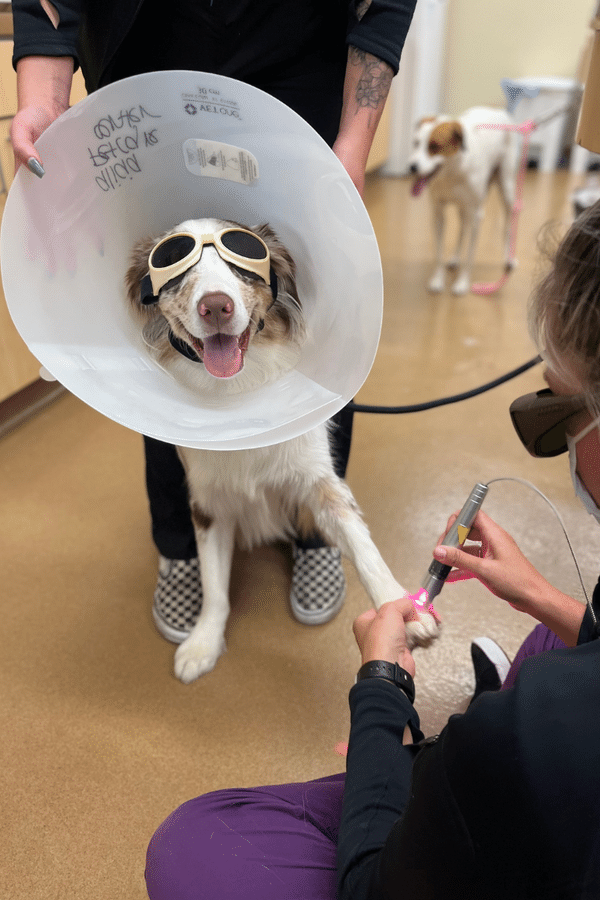
No, not the ones on the hind ends of foxes, but the wheat looking (evil) plant that seems to have a personal vendetta against dogs. At least I like to think so because it’s the only way to understand the havoc they cause to our furry friends. And the worst part is… a lot of pet owners don’t know about this insufferable plant until they have had the misfortune of dealing with it firsthand after it has caused some serious damage to their pet.


Above you can see what foxtail looks like from far away on a larger scale, and then on the right is a close-up image of the barbed seed head- that is what you will typically find in your dog’s ears or paw pads. They are relatively common out here in California. You can find them anywhere in the western United States. We personally treat at least one patient every other day during the height of foxtail season.
Case Study: Kona
Take a look at our beloved patient Kona. He went on a walk when his mom noticed this sore develop on his foot. After thorough examination of his foot, we could not find the fox tail, but we could see the path of destruction that it left. The foxtail caused a lot of inflammation and serious irritation inside his paw.



In the last image you can see where the foxtail likely left the back side of his paw pad. Kona did not require a surgical exploration of the region to look for the foxtail which is the typical scenario. There is usually a single hole, which is the draining tract, and the foxtail is still embedded somewhere in the foot or leg. They move in one direction and continue to move until they can’t, or they exit.
By the way, they have been found in EVERY region of the body including brain, heart, spine, etc, and we will get more into this later…
For Kona’s case, we found the probable exit. To help him heal properly, we gave him a watertight bandage wrap to keep the site safe from infection, but also keep to keep the wound safe from Kona licking at it (the challenges of Vet Med!). When we do a bandage change, we also sugar pack the area to prevent bacterial infection. It is imperative to redo the bandage wrap every few days to look for any developing signs of infection and prevent pressure spots.
He also received laser therapy as part of his treatment plan to reduce pain. If you haven’t heard of laser therapy before, laser energy increases circulation and draws water, oxygen, and nutrients to the damaged area. This creates an optimal healing environment that reduces inflammation, swelling, muscle spasms, stiffness and pain. As the injured area returns to normal, function is restored and pain is relieved. You can learn more about some of the amazing benefits of Laser Therapy on our website here.
Insert cute picture of Kona getting laser therapy below!

Why foxtails are so dangerous…
These foxtail seeds have a mind of their own. They always move forward- burrowing and digging with their spikes and barbs. Once they come in contact with the skin, paw, fur, nose, eyes, etc. (however your dog comes into contact with them) they will start their quest and never turn back. Foxtails will wreak havoc on your dog if given the opportunity and cause severe inflammation, abscesses, infection, swelling.
In some cases, a pet may require an exploratory surgery to track down the fox tail to prevent it from causing damage to internal organs. In the absolute worst-case scenarios: foxtails can cause death in a dog if they get into a lung or cause serious infection. So, it’s incredibly important to get them out.
What you can do
The foxtail season is May through December. Of course, it falls in line with when you and your dog are exploring nature most, right? Just be sure after every walk to thoroughly examine your pet from nose to paw to tail looking for any foxtails. It may even look like the end of a stinger. Just ask our RVT, Kati, who started pulling what she thought was a bee stinger from her adorable dog, Pygmy, only to find the stinger turn into a full fox tail!
If you notice your pet acting “weird” – shaking, limping, licking any specific part of the body after a walk, it would be a great idea to call your vet. (Also if you generally notice your pet acting weird, it’s a good idea to call your vet anyways!)
In conclusion, we rate foxtails a negative 1000 on a scale of 1 to 10.
Our office number is 949-768-1313 and we are located in Mission Viejo, California. We are taking new patients!


Recent Comments